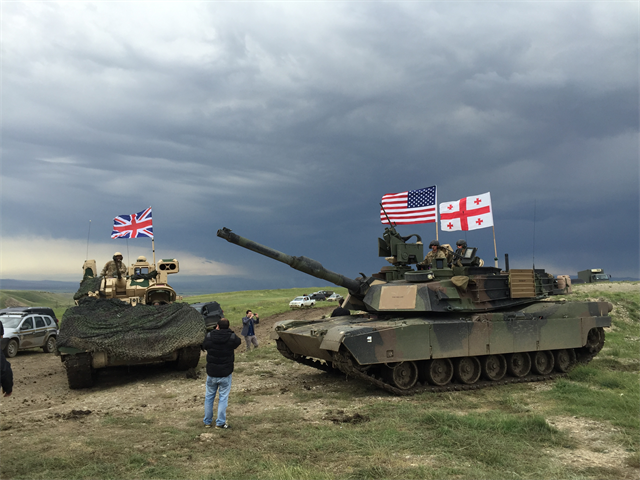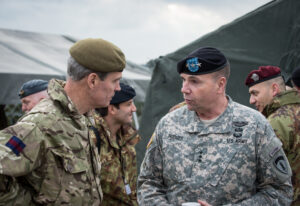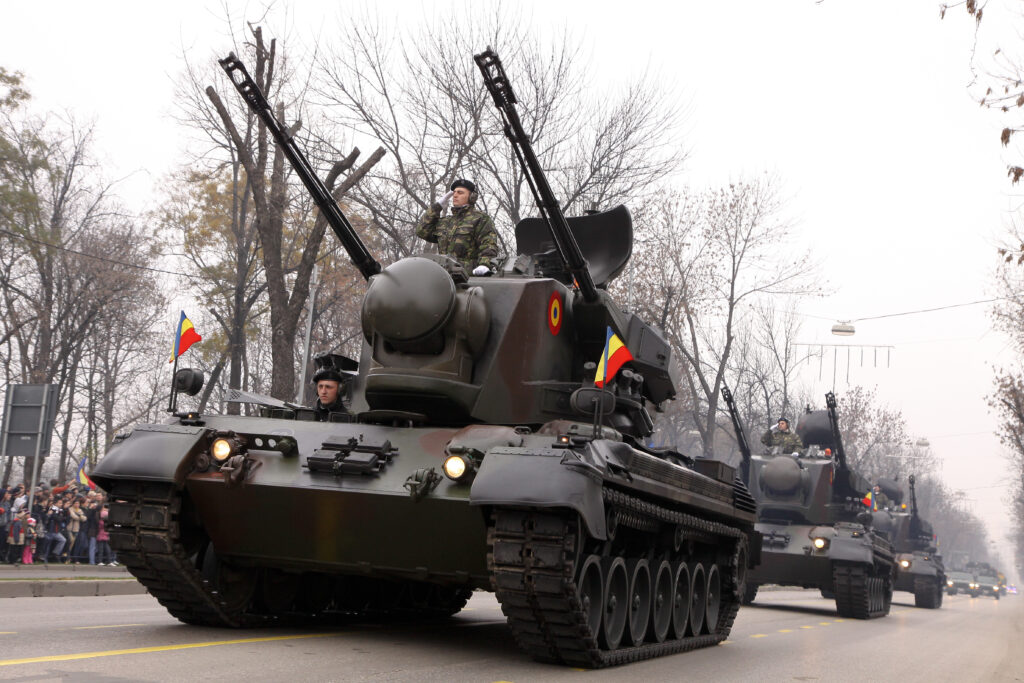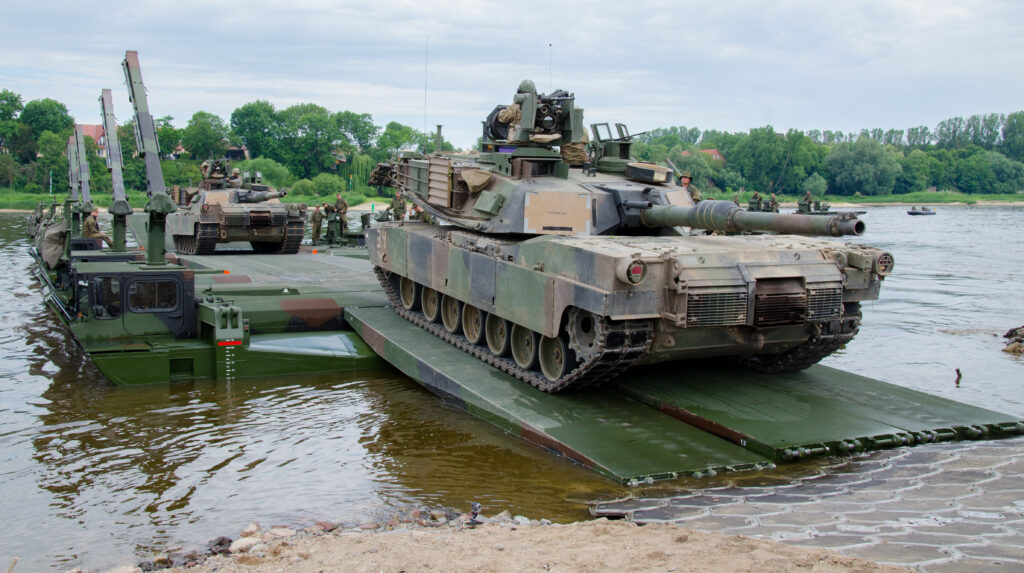
US armor flies US, UK, and Georgian flags during Exercise Noble Partner 2016.
WASHINGTON: War time is a bad time to run out of gas. If there was a crisis with Russia today, and a German unit needed to refuel from a US Army pump, they couldn’t do it. Why? The goddamn nozzle doesn’t fit. It’s just one of the host of seemingly minor shortfalls, from pontoon bridges to anti-aircraft guns, that could derail the alliance’s effectiveness if it isn’t fixed.
“We ought to be able to put the nozzle from an American tank-and-pump unit into every vehicle in the alliance, but we can’t right now,” Lt. Gen. Ben Hodges, commander of US Army Europe, told the annual Association of the US Army conference this week. “There is a NATO universal adapter for refueling, (but) only the French and the Americans have that.”

Lt. Gen. Ben Hodges talks to a British general during a NATO exercise.
“People need to buy that,” Hodges said bluntly. Napoleon famously said an army marches on its stomach — emphasizing the importance of steady rations — but a modern army drives on gas.
These problems aren’t new. NATO started working on compatible fuel nozzles 40 years ago — before most of today’s troops were even born — when the alliance got “a rude awakening that they couldn’t refuel each other’s vehicles,” said Frank Cevasco, who spent over a decade in the Pentagon as its top interoperability expert. To see this simple issue resurface after so many years, he told me, is “awful.”
Interoperability has waxed and waned over NATO’s history. The 1970s saw the first great awakening to the problem, Cevasco said. Even after the Soviet threat vanished in 1991 and NATO stopped preparing for a major war, militaries had enough interoperable equipment on hand from the 1980s, and enough common practices in their muscle memory, that “we and they coasted” for years, said Cevasco. By the late 1990s, however, the lack of focus and funding was taking a toll. Even after 911, when NATO joined the US intervention in Afghanistan, the allies learned how to cooperate in counterinsurgency, but they only got rustier at the complex logistics of large-scale mechanized campaigns.
The most crucial kind of interoperability is communications equipment. If you can’t call each other, you can’t coordinate operations or share intelligence. But regular radios won’t hold up to Russian jamming, eavesdropping, and triangulation. “If you do not have secure FM communications, guaranteed, the Russians are going to intercept it, they have UAVs (Unmanned Aerial Vehicles) all over the place, and you are going to be hit and killed,” said Hodges. And compatible communications is something we have to figure out ASAP, he said: “We’re only going to have five to seven days in a real crisis, so you’re going to have show up and plug right in.”
The Russians have a built-in advantage, said Lt. Gen. Jörg Vollmer, the German Army chief of staff, speaking alongside Hodges at AUSA: “They all speak the same language, they use the same doctrine, they use the same radios, and they use the same equipment.” The NATO allies have to work hard to get anywhere near the same level of unity — but it is possible. “We were very good in the old days, we were very good in Afghanistan,” said Vollmer. “We have to get all these capabilities back.”

German-made Gepard anti-aircraft vehicles in Romanian service.
Romanians Vs. Drones
Sometimes the problem is allies having different, incompatible equipment. But sometimes the last ally you’d expect has the critical hardware that the US is missing.
Consider mobile anti-aircraft units, which the US largely disbanded when the threat switched from Soviet jets and helicopters to roadside bombs and guerrilla foot troops. Now Russia is using small, cheap drones to scout out targets for artillery barrages, but all the US Army has to shoot drones down is a small number of expensive Stinger missiles. (The Stinger-launching Avenger batteries are all in the National Guard and pretty busy deployed to defend the homeland from another 911).

US Avenger anti-aircraft missile vehicle.
A far better counter to large numbers of cheap drones would be a good old-fashioned aircraft gun, firing cheap bullets instead of expensive missiles. The German-made Gepard (Cheetah), for example, was “a great air defense cannon mounted on a Leopard (tank) chassis,” Lt. Gen. Hodges told reporters after his public remarks. “I’d love to have that.”
Unfortunately, the Germans got rid of their Short-Range Air Defense (SHORAD) too. But some of the Gepards were given to smaller NATO allies, and some of these hand-me-down flak guns are still in service — notably in Romania. Now Hodges is hoping to recruit such an allied unit to provide air defense for the US-led Enhanced Forward Presence (EFP) battalion to be stationed in Poland.
“We’re looking at kind of a dual track,” Hodges told reporters. For the long term, the Army and other services are urgently developing counter-UAS (Unmanned Air System) technologies, from lasers to jammers to sniper rifles. “Counter-UAV would absolutely be in the top three or four things that we need” from the new Army Rapid Capability Office (ARCO), Hodges said. “And I am confident we are going to have some other systems that are coming down the road… but I need something now. (I’m) looking for an ally that will join our EFP battalion, for example, that would provide something they already have.”

US Army armor crosses the Elbe on German amphibious bridging.
Mines & Bridges
“The EFP battlegroups (are) a catalyst or a transmission belt to get all things together,” Vollmer said. Deploying four combat-ready battalions — Germany will leading the one in Lithuania — is a forcing function for figuring out everything required for a modern mechanized war.
For example, Vollmer said, NATO has “a whole generation of young engineers” who are experts in neutralizing roadside bombs, car bombs, and home-made mines. “But they have not laid mines,” he said, an essential skill for slowing down a Russian-style armored advance. “That is something (to) relearn.”

German Army chief of staff Lt. Gen. Jörg Vollmer
Engineers also have to relearn how to quickly bridge rivers, Vollmer said, and nations must rebuild their stocks of bridging gear. Overall, “it is relearning maneuver warfare (and) combined arms,” he said. “To rebuild these capabilities takes some time.”
“Most of the places where we have a shortage are things that we used to have in Europe: lots of bridges, lots of engineers, lots of rocket launchers, all those kinds of things,” Hodges told reporters. “Some of them are coming back. Some of them we’re finding with the allies.”
The US Army will stockpile additional equipment in Europe, Hodges said, amounting to most of an armored division: a division headquarters, a fires (artillery) brigade, a sustainment (logistics) brigade, and a maneuver (combat) brigade. US-based armored brigades will rotate through European deployments one after another, starting with the 3rd Brigade, 4th Infantry Division in January.
Hodges already has reactive armor tiles — blocks that detonate preemptively to deflect armor-piercing weapons — to put on the tanks. But, he said, the delicate art of attaching them is, yet again, “a skill set we have to relearn.”
Army closing in on selecting new spy-plane integrator, user assessment around late-2026
HADES is “designed to support active campaigning short of conflict and then potentially support targeting in conflicted areas where you might let high-end stealthy fighters or unmanned systems take first contact,” said Andrew Evans, the ISR Task Force director.



























